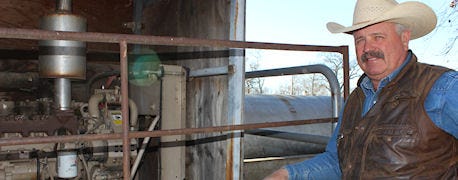April 3, 2013

By Kathy Coatney
An Arkansas professor has been experimenting with a farm-sized biodiesel plant that can use animal fat, waste oil or oilseeds.
Kevin Humphrey's system is not elaborate and he says it has a reasonably short pay-off.
The Arkansas State University researcher Humphrey sees real potential for ranchers with oil seed crops, waste oil or tallow to produce their own biodiesel. They could do it individually or as a group, pooling their resources to create a small biodiesel system, he says.
"If all you want to do is extract oil and meal, you can do that. If you want to extract and produce meal and then also produce biodiesel, you can do that," he says.

Might work: Darrell Wood, a beef producer from Leavitt Lake Ranch in Vina, California, is pondering whether a biodiesel plant on his ranch could economically power equipment such as this irrigation pump.
Humphrey is using waste oil and oil seed crops -- soybeans, canola, and camelina -- to make biodiesel. He adds he hasn't used animal fats but that is a viable option.
The equipment Humphrey is using produces about 32,000 gallons of biodiesel per year.
Equipment available
Biopro processors from Springboard Biodiesel in Chico, California, makes Humphrey's biodiesel. The Biopro processors come in three different sizes, 40-, 50- and 100-gallon processors. They range in price from $7,350 to $19,995.
Humphrey estimates about a $100,000 equipment investment for oil removal from the seed, including a mill to process the meal and the biodiesel processor. The payback can be relatively short, he says.
Matt Roberts, vice president of marketing for Springboard Biodiesel, says if the oil is collected free, as might be beef tallow from rendering, the biodiesel will cost about 95 cents per gallon to make. That price includes the cost of the chemicals to make the biodiesel -- methanol, lye, and sulfuric acid.
Tiny refinery: This is professor Humphrey's small biodiesel plant in Arkansas. It can produce 32,000 gallons of fuel per year.
The resulting biodiesel can be used in any diesel engine without needing to convert the engine.
Humphrey has worked a lot with soybeans because they are available. He says he will soon begin working with cottonseed.
Byproduct rewards
Crushing the seed to produce the oil creates a lot of meal that Humphrey grinds up for soybean meal. He's produced about eight tons of soybean meal within the last semester and a half, he says.
The meal is fed to the livestock on the campus farm, which provides dual usage from the seed crop.
~~~PAGE_BREAK_HERE~~~
Glycerin, a byproduct from the biodiesel production, can be used to make products like soaps, lotions and lubricants. If Humphrey can produce a semi-refined glycerin product, he says he can sell the glycerin, too.
Learning curve
There is a small learning curve to running the Biopro equipment but Roberts describes it similar to operating a high-end camera.
"You can put it on auto mode and do everything in auto, or you can go manual and get all artsy," he says.
Basically, you pour the oil poured into the machine, press start and it makes the biodiesel.
Humphrey agrees. "The biodiesel production is relatively easy as long as you make sure you're doing the right process, and you're cleaning your fuel," he says, adding they've had no problems using the biodiesel in their equipment.
Ranch usage
Darrell Wood, cattle rancher and owner of Leavitt Lake Ranches in Vina, California, thinks such a system might make sense for his operation. He raises and finishes grass-fed beef.
Wood says they must give away the excess fat from their processing, so using it to make biodiesel is an option he's considering.
The idea also has appeal because it would help make the ranch sustainable, Wood says. The biodiesel could be used in his farming equipment, irrigation pumps and maybe even some of the cattle trucks that haul the beef.
"It just opens the door for all kinds of possibilities," Wood says.
Coatney writes from Corning, California.
You May Also Like




